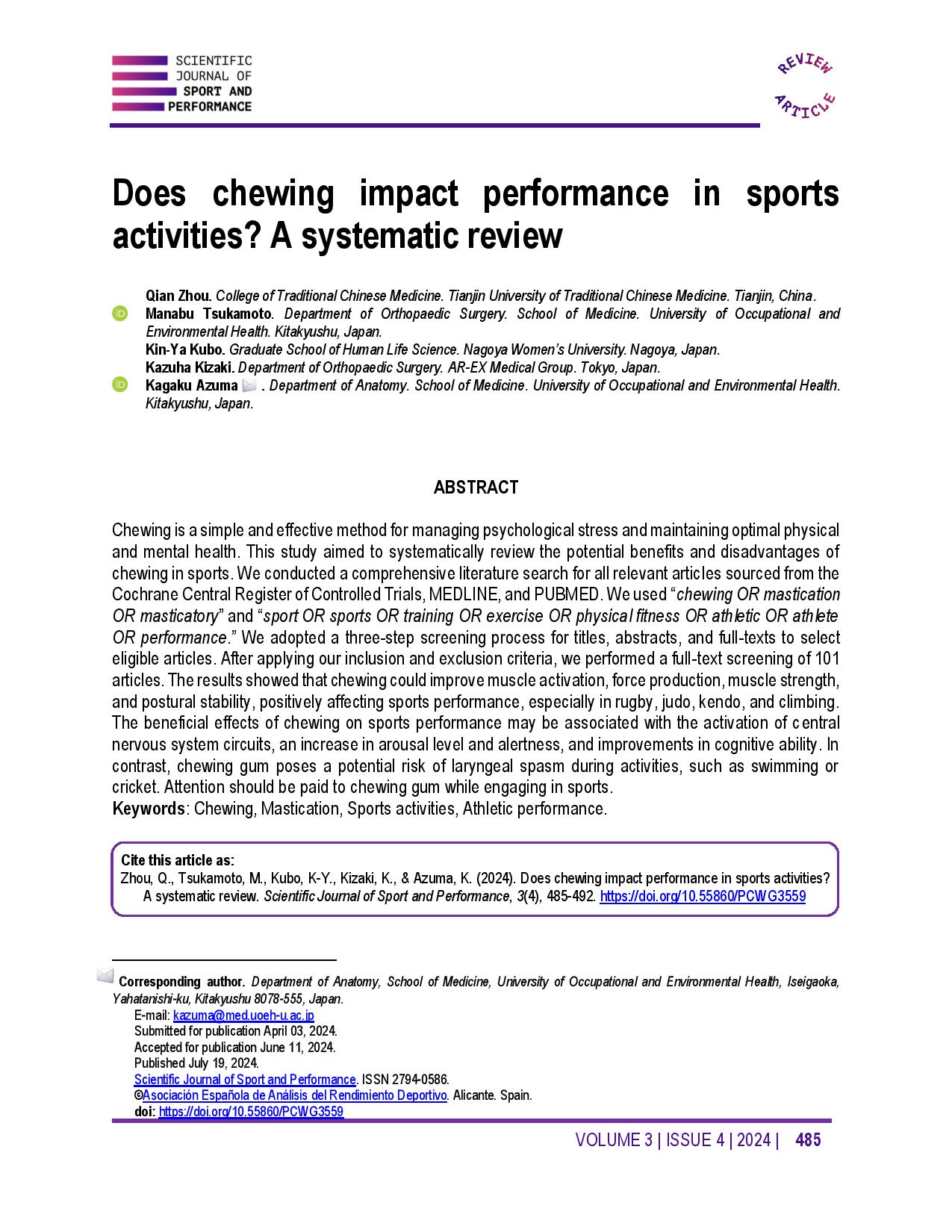Does chewing impact performance in sports activities? A systematic review
Main Article Content
Abstract
Chewing is a simple and effective method for managing psychological stress and maintaining optimal physical and mental health. This study aimed to systematically review the potential benefits and disadvantages of chewing in sports. We conducted a comprehensive literature search for all relevant articles sourced from the Cochrane Central Register of Controlled Trials, MEDLINE, and PUBMED. We used “chewing OR mastication OR masticatory” and “sport OR sports OR training OR exercise OR physical fitness OR athletic OR athlete OR performance.” We adopted a three-step screening process for titles, abstracts, and full-texts to select eligible articles. After applying our inclusion and exclusion criteria, we performed a full-text screening of 101 articles. The results showed that chewing could improve muscle activation, force production, muscle strength, and postural stability, positively affecting sports performance, especially in rugby, judo, kendo, and climbing. The beneficial effects of chewing on sports performance may be associated with the activation of central nervous system circuits, an increase in arousal level and alertness, and improvements in cognitive ability. In contrast, chewing gum poses a potential risk of laryngeal spasm during activities, such as swimming or cricket. Attention should be paid to chewing gum while engaging in sports.
Article Details

This work is licensed under a Creative Commons Attribution-NonCommercial-ShareAlike 4.0 International License.
References
Azuma, K., Zhou, Q., Niwa, M., & Kubo, K. Y. (2017). Association between Mastication, the Hippocampus, and the HPA Axis: A Comprehensive Review. Int J Mol Sci, 18(8), 1687. https://doi.org/10.3390/ijms18081687 DOI: https://doi.org/10.3390/ijms18081687
Banakar, M., Moayedi, S., Shamsoddin, E., Vahedi, Z., Banakar, M. H., Mousavi, S. M., . . . Bagheri Lankarani, K. (2022). Chewing Gums as a Drug Delivery Approach for Oral Health. Int J Dent, 2022, 9430988. https://doi.org/10.1155/2022/9430988 DOI: https://doi.org/10.1155/2022/9430988
Bourke, J. B. (1979). Gum chewing at cricket. Lancet, 1(8111), 326-327. https://doi.org/10.1016/S0140-6736(79)90739-6 DOI: https://doi.org/10.1016/S0140-6736(79)90739-6
Falardeau, D., Dubois, S., & Kolta, A. (2023). The coordination of chewing. Curr Opin Neurobiol, 83, 102805. https://doi.org/10.1016/j.conb.2023.102805 DOI: https://doi.org/10.1016/j.conb.2023.102805
Fukumasa, H., Tsuji, S., Kawamura, K., & Nishimura, N. (2020). Upper airway obstruction in an adolescent: Can airway foreign bodies be missed without self-reporting? Respir Med Case Rep, 29, 101029. https://doi.org/10.1016/j.rmcr.2020.101029 DOI: https://doi.org/10.1016/j.rmcr.2020.101029
Gaszynska, E., Godala, M., Szatko, F., & Gaszynski, T. (2014). Masseter muscle tension, chewing ability, and selected parameters of physical fitness in elderly care home residents in Lodz, Poland. Clin Interv Aging, 9, 1197-1203. https://doi.org/10.2147/CIA.S66672 DOI: https://doi.org/10.2147/CIA.S66672
Ginszt, M., Zielinski, G., Bys, A., Gawda, P., & Majcher, P. (2020). Masticatory Muscles Activity in Sport Climbers. Int J Environ Res Public Health, 17(4). https://doi.org/10.3390/ijerph17041378 DOI: https://doi.org/10.3390/ijerph17041378
Green, R. (1979). Gum chewing in sport. Lancet, 1(8117), 675-676. https://doi.org/10.1016/S0140-6736(79)91128-0 DOI: https://doi.org/10.1016/S0140-6736(79)91128-0
Hirano, Y., Obata, T., Takahashi, H., Tachibana, A., Kuroiwa, D., Takahashi, T., . . . Onozuka, M. (2013). Effects of chewing on cognitive processing speed. Brain Cogn, 81(3), 376-381. https://doi.org/10.1016/j.bandc.2012.12.002 DOI: https://doi.org/10.1016/j.bandc.2012.12.002
Hollis, J. H. (2018). The effect of mastication on food intake, satiety and body weight. Physiol Behav, 193(Pt B), 242-245. https://doi.org/10.1016/j.physbeh.2018.04.027 DOI: https://doi.org/10.1016/j.physbeh.2018.04.027
Iwasaki, H., Inaba, R., & Iwata, H. (1994). [Biting force and physical fitness in athletes]. Nihon Eiseigaku Zasshi, 49(3), 654-659. https://doi.org/10.1265/jjh.49.654 DOI: https://doi.org/10.1265/jjh.49.654
Kanzaki, H., Wada, S., Kumazawa, M., Yamada, Y., Sudo, T., Ozawa, E., . . . Tomonari, H. (2019). Mandibular prognathism attenuates brain blood flow induced by chewing. Sci Rep, 9(1), 19104. https://doi.org/10.1038/s41598-019-55553-5 DOI: https://doi.org/10.1038/s41598-019-55553-5
Katsuhide Kurokawa, K. N., Masahiko Maeda, Tomotaka Takeda, Keiichi Ishigami. (2008). The effects of gum chewing on the body reaction time. Int J Sports Dent, 1(1), 47-53.
Kubo, K. Y., Iinuma, M., & Chen, H. (2015). Mastication as a Stress-Coping Behavior. Biomed Res Int, 2015, 876409. https://doi.org/10.1155/2015/876409 DOI: https://doi.org/10.1155/2015/876409
Kushiro, K., & Goto, F. (2011). Effect of masticating chewing gum on postural stability during upright standing. Neurosci Lett, 487(2), 196-198. https://doi.org/10.1016/j.neulet.2010.10.021 DOI: https://doi.org/10.1016/j.neulet.2010.10.021
Luo, J., Xia, M., & Zhang, C. (2022). The Effects of Chewing Gum on Reducing Anxiety and Stress: A Meta-Analysis of Randomized Controlled Trials. J Healthc Eng, 2022, 8606693. https://doi.org/10.1155/2022/8606693 DOI: https://doi.org/10.1155/2022/8606693
Malm, C., Jakobsson, J., & Isaksson, A. (2019). Physical Activity and Sports-Real Health Benefits: A Review with Insight into the Public Health of Sweden. Sports (Basel), 7(5), 127. https://doi.org/10.3390/sports7050127 DOI: https://doi.org/10.3390/sports7050127
Okuma, N., Saita, M., Hoshi, N., Soga, T., Tomita, M., Sugimoto, M., & Kimoto, K. (2017). Effect of masticatory stimulation on the quantity and quality of saliva and the salivary metabolomic profile. PLoS One, 12(8), e0183109. https://doi.org/10.1371/journal.pone.0183109 DOI: https://doi.org/10.1371/journal.pone.0183109
Pojednic, R., D'Arpino, E., Halliday, I., & Bantham, A. (2022). The Benefits of Physical Activity for People with Obesity, Independent of Weight Loss: A Systematic Review. Int J Environ Res Public Health, 19(9), 4981. https://doi.org/10.3390/ijerph19094981 DOI: https://doi.org/10.3390/ijerph19094981
Prinz, J. F., & Lucas, P. W. (2001). "The first bite of the cherry": Intra-oral manipulation prior to the first bite in humans. J Oral Rehabil, 28(7), 614-617. https://doi.org/10.1046/j.1365-2842.2001.00732.x DOI: https://doi.org/10.1046/j.1365-2842.2001.00732.x
Singh, B., Olds, T., Curtis, R., Dumuid, D., Virgara, R., Watson, A., . . . Maher, C. (2023). Effectiveness of physical activity interventions for improving depression, anxiety and distress: an overview of systematic reviews. Br J Sports Med, 57(18), 1203-1209. https://doi.org/10.1136/bjsports-2022-106195 DOI: https://doi.org/10.1136/bjsports-2022-106195
Siroka, S. A., & Knobel, G. J. (1991). Danger of chewing gum while participating in a sport. S Afr Med J, 79(9), 565-566.
Vuillerme, N., & Nafati, G. (2007). How attentional focus on body sway affects postural control during quiet standing. Psychol Res, 71(2), 192-200. https://doi.org/10.1007/s00426-005-0018-2 DOI: https://doi.org/10.1007/s00426-005-0018-2
Yeung, C. Y., Chu, C. H., & Yu, O. Y. (2023). A concise review of chewing gum as an anti-cariogenic agent. Front Oral Health, 4, 1213523. https://doi.org/10.3389/froh.2023.1213523 DOI: https://doi.org/10.3389/froh.2023.1213523




